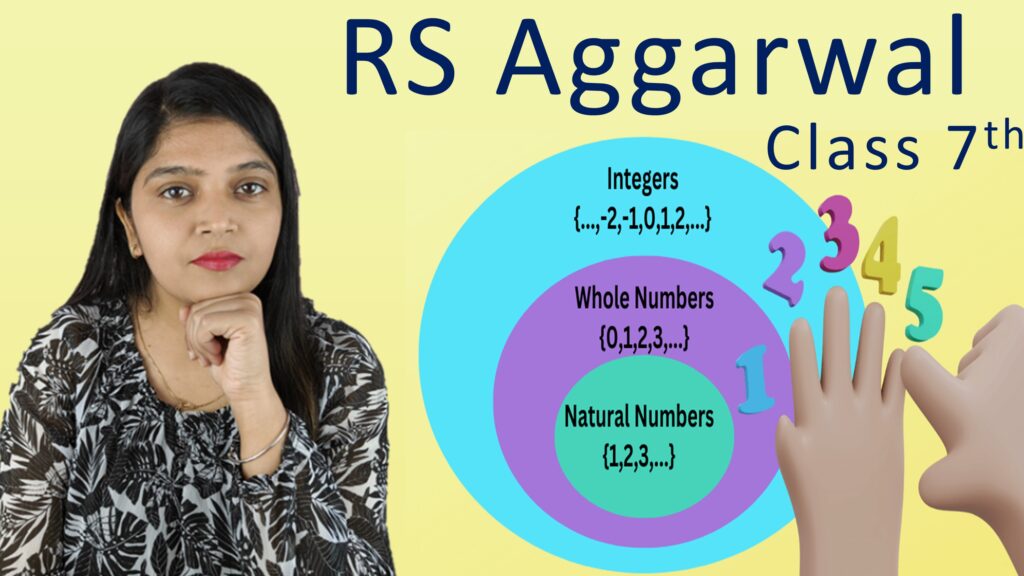Exercise: 4-I
Multiple Choice Type
Q1: The additive inverse of \(\frac{5}{9}\) is
Step 1: Understand the definition of additive inverse.
The **additive inverse** of a number is the number that when **added** to the original gives **zero**.
Step 2: Find the number which when added to \(\frac{5}{9}\) gives 0.
Let the additive inverse be \(x\). So,
\[
\frac{5}{9} + x = 0
\]
Solving for \(x\),
\[
x = -\frac{5}{9}
\]Answer: b. \(-\frac{5}{9}\)
Q2: The rational number \(\frac{32}{-40}\) expressed in standard form is
Step 1: Recall that the standard form of a rational number has the negative sign (if any) only in the numerator.
Step 2: Simplify \(\frac{32}{-40}\) by dividing numerator and denominator by their greatest common divisor (GCD).
GCD of 32 and 40 is 8.
\[
\frac{32}{-40} = \frac{32 \div 8}{-40 \div 8} = \frac{4}{-5}
\]Step 3: Rewrite \(\frac{4}{-5}\) as \(\frac{-4}{5}\) to put the negative sign in numerator (standard form).
\[
\frac{4}{-5} = \frac{-4}{5}
\]Answer: d. \(\frac{-4}{5}\)
Q3: What should be added to \(\frac{-3}{16}\) get \(\frac{5}{8}\)?
Step 1: Let the required number be \(x\). Then,
\[
\frac{-3}{16} + x = \frac{5}{8}
\]Step 2: Solve for \(x\):
\[
x = \frac{5}{8} – \frac{-3}{16} = \frac{5}{8} + \frac{3}{16}
\]Step 3: Find common denominator (LCM of 8 and 16 is 16) and add:
\[
\frac{5}{8} = \frac{5 \times 2}{8 \times 2} = \frac{10}{16}
\]
\[
x = \frac{10}{16} + \frac{3}{16} = \frac{13}{16}
\]Answer: d. \(\frac{13}{16}\)
Q4: The multiplicative inverse of \(\frac{-3}{7}\) is:
Step 1: Recall that the multiplicative inverse (or reciprocal) of a rational number \(\frac{a}{b}\) is \(\frac{b}{a}\), such that
\[
\frac{a}{b} \times \frac{b}{a} = 1
\]Step 2: For \(\frac{-3}{7}\), the reciprocal is
\[
\frac{7}{-3} = \frac{-7}{3}
\]Step 3: Check the product:
\[
\frac{-3}{7} \times \frac{-7}{3} = \frac{21}{21} = 1
\]Answer: a. \(\frac{-7}{3}\)
Q5: The sum of \(-\frac{1}{3}\) and its multiplicative is
Step 1: Find the multiplicative inverse (reciprocal) of \(-\frac{1}{3}\).
\[
\text{Multiplicative inverse of } -\frac{1}{3} = -3
\]Step 2: Now, add the number and its reciprocal:
\[
-\frac{1}{3} + (-3) = -\frac{1}{3} – 3
\]Step 3: Convert \(-3\) to fraction with denominator 3:
\[
-3 = -\frac{9}{3}
\]Step 4: Add the fractions:
\[
-\frac{1}{3} – \frac{9}{3} = -\frac{10}{3}
\]Step 5: Convert \(-\frac{10}{3}\) into a mixed fraction:
\[
-\frac{10}{3} = -3\frac{1}{3}
\]Answer: d. \(-3\frac{1}{3}\)
Q6: The product of \(-\frac{1}{3}\) and its additive is
Step 1: Find the additive inverse of \(-\frac{1}{3}\).
\[
\text{Additive inverse of } -\frac{1}{3} = \frac{1}{3}
\]Step 2: Now, find the product of \(-\frac{1}{3}\) and \(\frac{1}{3}\):
\[
-\frac{1}{3} \times \frac{1}{3} = -\frac{1 \times 1}{3 \times 3} = -\frac{1}{9}
\]Answer: c. \(-\frac{1}{9}\)
Q7: Which of the rational numbers is equivalent to \(\frac{-2}{7}\)?
Step 1: Understand that two rational numbers \(\frac{a}{b}\) and \(\frac{c}{d}\) are equivalent if:
\[
a \times d = b \times c
\]Step 2: Check each option one by one:a. \(\frac{-14}{21}\): Check if \(-2 \times 21 = 7 \times -14\)
\[
-2 \times 21 = -42, \quad 7 \times (-14) = -98 \quad \Rightarrow \text{Not equal}
\]b. \(\frac{-8}{14}\): Check if \(-2 \times 14 = 7 \times -8\)
\[
-2 \times 14 = -28, \quad 7 \times (-8) = -56 \quad \Rightarrow \text{Not equal}
\]c. \(\frac{-14}{49}\): Check if \(-2 \times 49 = 7 \times -14\)
\[
-2 \times 49 = -98, \quad 7 \times (-14) = -98 \quad \Rightarrow \text{Equal!}
\]d. \(\frac{-6}{28}\): Check if \(-2 \times 28 = 7 \times -6\)
\[
-2 \times 28 = -56, \quad 7 \times (-6) = -42 \quad \Rightarrow \text{Not equal}
\]Answer: c. \(\frac{-14}{49}\)
Q8: If \(3\frac{3}{4}\) m of cloth is required for one suit, then how many suits be prepared from 30 m of cloth?
Step 1: Convert the mixed fraction \(3\frac{3}{4}\) to an improper fraction:
\[
3\frac{3}{4} = \frac{3 \times 4 + 3}{4} = \frac{12 + 3}{4} = \frac{15}{4}
\]Step 2: Let the number of suits be \(x\). Then,
\[
x \times \frac{15}{4} = 30
\]Step 3: Solve for \(x\):
\[
x = \frac{30}{\frac{15}{4}} = 30 \times \frac{4}{15} = \frac{30 \times 4}{15} = \frac{120}{15} = 8
\]Answer: c. 8 suits







Leave a Comment